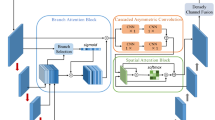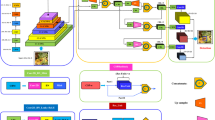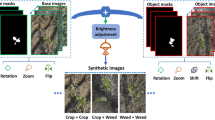Abstract
In field weed detection tasks, achieving accurate identification of crops and weeds is the primary target. However, since small target weeds among crops are not easily detected, this undoubtedly increases the difficulty of detection. In order to solve this problem, based on the YOLO-V4 network, this paper modifies the residual block of the backbone network into a Res2block residual block with a hierarchical residual mode, and constructs a new backbone network Csp2Darknet53 to enhance fine-grained feature detection; In addition, receptive field enlargement and multi-scale fusion are achieved by using the I-SPP structure with multi-branch structure and dilated convolution; Finally, a depthwise separable convolution block with residual mode (IDSC-X) is proposed to replace the original 5-time convolution block in the path aggregation network (PANet) to ensure that the original features are not completely lost and reduce the amount of parameters. Compared with FasterR-CNN, SSD, MaskR-CNN, YOLO-V3 and YOLO-V4, the improved network detection accuracy is significantly better than other networks. Compared with YOLO-V4, the AP value of small target weeds increased by 15.1%, the mAP value increased by 4.2%, and the model parameters and training weight file size decreased by 34%. The results show that the method is feasible to improve the accurate detection of small target weeds, and can be extended to weed detection tasks of different crops.














Similar content being viewed by others
References
Aversano, L., Bernardi, M., Cimitile, M., Iammarino, M., Rondinella, S. (2020). Tomato diseases Classification Based on VGG and Transfer Learning. In Proceedings of the 2020 IEEE International Workshop on Metrology for Agriculture and Forestry (MetroAgriFor) (pp. 129–133).IEEE. https://doi.org/10.1109/MetroAgriFor50201.2020.9277626
Bochkovskiy, A., Wang, C. Y., & Liao, H. Y. M. (2020). Yolov4: Optimal speed and accuracy of object detection. arXiv preprint arXiv: 2004.10934. https://doi.org/10.48550/arXiv.2004.10934
Chen, J., Wang, H., Zhang, H., Luo, T., Wei, D., Long, T., & Wang, Z. (2022). Weed detection in sesame fields using a YOLO model with an enhanced attention mechanism and feature fusion. Computers & Electronics in Agriculture, 202, 107412. https://doi.org/10.1016/j.compag.2022.107412
Fu, L., Gao, F., Wu, J., Li, R., Karkee, M., & Zhang, Q. (2020). Application of consumer RGB-D cameras for fruit detection and localization in field: A critical review. Computers & Electronics in Agriculture, 177, 105687. https://doi.org/10.1016/j.compag.2020.105687
Goutte, C., & Gaussier, E. (2005). A probabilistic interpretation of precision, recall and F-score, with implication for evaluation. In European Conference on Information Retrieval (pp. 345–359). Santiago de Compostela, Spain. https://doi.org/10.1007/978-3-540-31865-1_25
Hasan, A. M., Sohel, F., Diepeveen, D., Laga, H., & Jones, M. G. (2021). A survey of deep learning techniques for weed detection from images. Computers & Electronics in Agriculture, 184, 106067. https://doi.org/10.1016/j.compag.2021.106067
He, K., Zhang, X., Ren, S., & Sun, J. (2016). Deep residual learning for image recognition. In Proceedings of the IEEE conference on computer vision and pattern recognition (pp. 770–778). https://doi.org/10.1109/CVPR.2016.90
Holt, J. S. (2004). Principles of weed management in agroecosystems and wildlands1. Weed Technology, 18(sp1), 1559–1562. https://doi.org/10.1614/0890-037X(2004)018[1559:POWMIA]2.0.CO;2
Hu, D., Ma, C., Tian, Z., Shen, G., & Li, L. (2021). Rice Weed detection method on YOLOv4 convolutional neural network. In 2021 International Conference on Artificial Intelligence, Big Data and Algorithms (CAIBDA) (pp. 41–45). IEEE. https://doi.org/10.1109/CAIBDA53561.2021.00016
Iqbal, N., Manalil, S., Chauhan, B. S., & Adkins, S. W. (2019). Investigation of alternate herbicides for effective weed management in glyphosate-tolerant cotton. Archives of Agronomy and Soil Science, 65(13), 1885–1899. https://doi.org/10.1080/03650340.2019.1579904
Kumar, D. A., & Prema, P. (2016). a novel wrapping curvelet transformation based angular texture pattern (WCTATP) extraction method for weed identification. ICTACT Journal on Image & Video Processing. https://doi.org/10.21917/ijivp.2016.0174
Liu, S., Qi, L., Qin, H., Shi, J., & Jia, J. (2018). Path aggregation network for instance segmentation. In Proceedings of the IEEE conference on computer vision and pattern recognition (pp. 8759–8768). https://doi.org/10.1109/CVPR.2018.00913
Liu, B., & Bruch, R. (2020). Weed detection for selective spraying: A review. Current Robotics Reports, 1(1), 19–26. https://doi.org/10.1007/s43154-020-00001-w
Misra, D. (2019). Mish: A self regularized non-monotonic activation function. arXiv preprint arXiv:1908.08681. https://doi.org/10.48550/arXiv.1908.08681
Parico, A. I. B., & Ahamed, T. (2020). An aerial weed detection system for green onion crops using the you only look once (YOLOv3) deep learning algorithm. Engineering in Agriculture, Environment and Food, 13(2), 42–48. https://doi.org/10.37221/eaef.13.2_42
Patidar, S., Singh, U., Sharma, S., & Himanshu. (2020). Weed Seedling Detection Using Mask Regional Convolutional Neural Network. In Prcnational Conference on Electronics and Sustainable Communication Systems (ICESC) (pp. 311–316). IEEE. https://doi.org/10.1109/ICESC48915.2020.9155701
Quan, L., Feng, H., Lv, Y., Wang, Q., Zhang, C., Liu, J., & Yuan, Z. (2019). Maize seedling detection under different growth stages and complex field environments based on an improved Faster R-CNN. Biosystems Engineering, 184, 1–23. https://doi.org/10.1016/j.biosystemseng.2019.05.002
Radoglou-Grammatikis, P., Sarigiannidis, P., Lagkas, T., & Moscholios, I. (2020). A compilation of UAV applications for precision agriculture. Computer Networks, 172, 107148. https://doi.org/10.1016/j.comnet.2020.107148
Redmon, J., & Farhadi, A. (2018). Yolov3: An incremental improvement. arXiv preprint arXiv:1804.02767. https://doi.org/10.48550/arXiv.1804.02767
Ren, S., He, K., Girshick, R., & Sun, J. (2015). Faster R-CNN: Towards real-time object detection with region proposal networks. Advances in Neural Information Processing Systems. https://doi.org/10.1109/TPAMI.2016.2577031
Roy, A. M., & Bhaduri, J. (2022). Real-time growth stage detection model for high degree of occultation using DenseNet-fused YOLOv4. Computers & Electronics in Agriculture, 193, 106694. https://doi.org/10.1016/j.compag.2022.106694
Redmon, J., Divvala, S., Girshick, R., Farhadi, A. (2016). You only look once: unified, real-time object detection. In Proceedings of the IEEE conference on computer vision and pattern Recognition (pp. 779–788). https://doi.org/10.1109/CVPR.2016.91
Sandler, M., Howard, A., Zhu, M., Zhmoginov, A., & Chen, L. C. (2018). Mobilenetv2: Inverted residuals and linear bottlenecks. In Proceedings of the IEEE conference on computer vision and pattern recognition (pp. 4510–4520). https://doi.org/10.1109/CVPR.2018.00474
Sujaritha, M., Annadurai, S., Satheeshkumar, J., Sharan, S. K., & Mahesh, L. (2017). Weed detecting robot in sugarcane fields using fuzzy real time classifier. Computers & Electronics in Agriculture, 134, 160–171. https://doi.org/10.1016/j.compag.2017.01.008
Tang, J. L., Chen, X. Q., Miao, R. H., & Wang, D. (2016). Weed detection using image processing under different illumination for site-specific areas spraying. Computers & Electronics in Agriculture, 122, 103–111. https://doi.org/10.1016/j.compag.2015.12.016
Wen, L., Liming, X., & Jiejie, X. (2017). Research status of mechanical intra-row weed control in row crops. Journal of Agricultural Mechanization Research, 39(1), 243–250. https://doi.org/10.3969/j.issn.1003-188X.2017.01.048
Ying, B., Xu, Y., Zhang, S., Shi, Y., & Liu, L. (2021). Weed detection in images of carrot fields based on improved YOLO v4. Traitement du Signal. https://doi.org/10.18280/ts.380211
Zheng, T., Jiang, M., Li, Y., & Feng, M. (2022). Research on tomato detection in natural environment based on RC-YOLOv4. Computers & Electronics in Agriculture, 198, 107029. https://doi.org/10.1016/j.compag.2022.107029
Zhu, W., & Zhu, X. (2009). The application of support vector machine in weed classification. In 2009 IEEE International Conference on Intelligent Computing and Intelligent Systems (Vol. 4, pp. 532–536).IEEE. https://doi.org/10.1109/ICICISYS.2009.5357638
Acknowledgements
This work was supported by the Talent Start-up Project of the University's Scientific Research Fund and “Pioneer” and “Leading Goose” R&D Program of Zhejiang under Grant 2022C02042. The authors would like to thank all the anonymous reviewers and editors for their useful comments and suggestions that greatly improved this paper.
Author information
Authors and Affiliations
Contributions
HW: methodology, software, validation, formal analysis, investigation, writing—original draft, writing—review and editing, visualization. MQ: resources supervision, project administration, funding acquisition. YW: methodology, formal analysis. PZ: methodology, formal analysis.
Corresponding author
Ethics declarations
Competing interest
The authors declare that they have no known competing financial interests or personal relationships that could have appeared to influence the work reported in this paper.
Additional information
Publisher's Note
Springer Nature remains neutral with regard to jurisdictional claims in published maps and institutional affiliations.
Rights and permissions
Springer Nature or its licensor (e.g. a society or other partner) holds exclusive rights to this article under a publishing agreement with the author(s) or other rightsholder(s); author self-archiving of the accepted manuscript version of this article is solely governed by the terms of such publishing agreement and applicable law.
About this article
Cite this article
Wu, H., Wang, Y., Zhao, P. et al. Small-target weed-detection model based on YOLO-V4 with improved backbone and neck structures. Precision Agric 24, 2149–2170 (2023). https://doi.org/10.1007/s11119-023-10035-7
Accepted:
Published:
Issue Date:
DOI: https://doi.org/10.1007/s11119-023-10035-7




